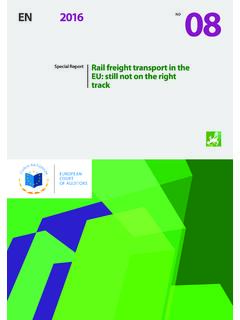Transcription of CHECKLISTS FOR USE IN FINANCIAL AND COMPLIANCE …
1 CHECKLISTS FOR USE IN FINANCIAL AND. COMPLIANCE audit OF PUBLIC PROCUREMENT. Page 1 of 58. INTRODUCTION. The scope of public procurement is broad and incorporates a wide range of activities including, acquiring goods and services at an appropriate quality and quantity, bundling supply needs with other departments, outsourcing services and establishing partnerships with suppliers. In all cases the public body has to choose a supplier and pay for the goods delivered or service provided. In most of the EU Member States, procurement represents between 25% to 30% of public spending. Supreme audit Institutions (SAIs) audit the use of public resources and, depending on mandates, may also promote sound management principles and the attainment of value.
2 The audit mandates and activities of SAIs vary, as do national budgeting systems and public procurement regulations. Drafting a common checklist to be used when auditing public procurement processes was a difficult task, not least because we had to produce a document which was relevant and applicable to auditors operating within different frameworks, objectives, requirements and procedures. An auditor may examine the procurement function as part of an audit of the accounts of a specific public authority. Alternatively he/she may be interested in examining specific areas or procedures and in considering efficiency, competition, fraud and corruption, regularity, fitness for purpose or value added.
3 Some SAIs may strive to recommend good practice while others may concentrate on matters of COMPLIANCE and the action taken in response to identified irregularities. The checklist was prepared on the basis of common principles and procedures having regard to: An analysis of the contributions received from several of the SAIs which led us to conclude that all of them focus on the robustness of the procurement function, meeting public needs, competition objectives and transparent procedures;. EU Member States are bound to the basic precepts of the Treaty on the Functioning of the European Union (TFUE) and of the Directive 2004/18/EC1.
4 No matter which national or local regulation is followed, State authorities must respect the requirements of the competitive process and make its decisions in a transparent way which respects all participants equally. In particular it must not discriminate on the grounds of nationality;. Procurement is a risk area for fraud and corruption and they usually result in the misuse of public resources. While the CHECKLISTS closely follow the requirements of the EU Directive, they are general in nature and is applicable to purchases falling below the EU threshold limits. They also address some relevant questions not included in the EU Directive, organisational issues.
5 In addition, we have placed emphasis on aspects which we know from experience are prone to failure and irregular influence. 1. Although there are other EU regulations on public procurement, this checklist refers always to Directive 2004/18/EC. ruling. Page 2 of 58. When using this checklist, the auditor should keep in mind that: The evaluation of public procurement processes may be only a part of the audit (as in the case of a FINANCIAL audit ), and, thus, the proposed questions may have to be integrated within the broad methodology of that audit ;. Depending on assessed risks, not all questions will be applicable to each audit .
6 According to audit mandates and national systems, some items may have to be modified or questions added. For instance, financing through national, state or local budgets will put the procuring entity under the obligation of following the relevant national, state or local FINANCIAL and procurement regulations;. Where an audit is planned to include value for money questions, items from these CHECKLISTS should be considered along with those included in the Procurement Performance Model. The CHECKLISTS begin with an analysis of the procurement function, and thereafter is organised according to the main stages of the procurement process such as pre-tender stage, choice of procurement procedure, publicity and notifications used, identification of potential bidders, evaluation of tenders and award procedure.
7 A. specific attention is given to additional works and supplies as a frequent form of direct contracting. Each chapter has a number of main questions, which are then presented in the following format: Background, explaining the importance and giving some relevant information;. Questions, detailing the areas and directions in which that item should be investigated;. Guidance, identifying documents that the auditor should consider in relation to the item under analysis: - The relevant parts of the Directive 2004/18/EC;. - The related sections of the Guideline for Auditors;. - Questions included in the Procurement Performance Model.
8 - Important judgements of the European Court of Justice (ECJ Case-Law);. - audit reports and studies produced by SAIs2. Since public procurement is one of the activities creating more opportunities for corruption, which originate damages estimated between 10% to 50% of the contract value, we have included a fraud and corruption perspective in these CHECKLISTS . Where the audit emphasis is on fraud and corrupt practices, then the auditor should take F/C. special note of those questions highlighted with the following red flag: . If the answer to those questions is No increased risks of fraud and corruption are probable and further analysis is needed3.
9 2. Summaries, details and links to these reports are included in Supreme audit Institutions Summaries of Procurement 3. See AFROSAI-E guideline Detecting fraud while auditing for a global approach, for fraud checklist and for audit procedures, risks and suggested controls for selected audit areas, including procurement (on request to AFROSAIE). For types of fraud and corruption in contracts and warning signs of possible fraud and corruption in contracts see ASOSAI Guidelines for Dealing with Fraud and Corruption in: See also Fighting Corruption and Promoting Integrity in Public Procurement, OECD, 2005. Page 3 of 58. 1. AUDITING THE MANAGEMENT OF THE PROCUREMENT FUNCTION.
10 Are procurement processes well organised and documented? Are proper financing arrangements taken? Are internal control systems in place? Is procurement execution duly monitored and documented? 2. AUDITING THE PREPARATION OF THE PROCUREMENT. Are EU procurement regulations applicable? Did the public authority calculate the contract value accurately? Was the performance description adequate to needs and legal requirements? Were the tender documents comprehensive, transparent and free from restrictions or conditions which would discriminate against certain suppliers? Was the submission of variant tenders accepted and duly ruled? Has the public authority procedures in place to monitor the input of experts employed to assist the procurement function?










